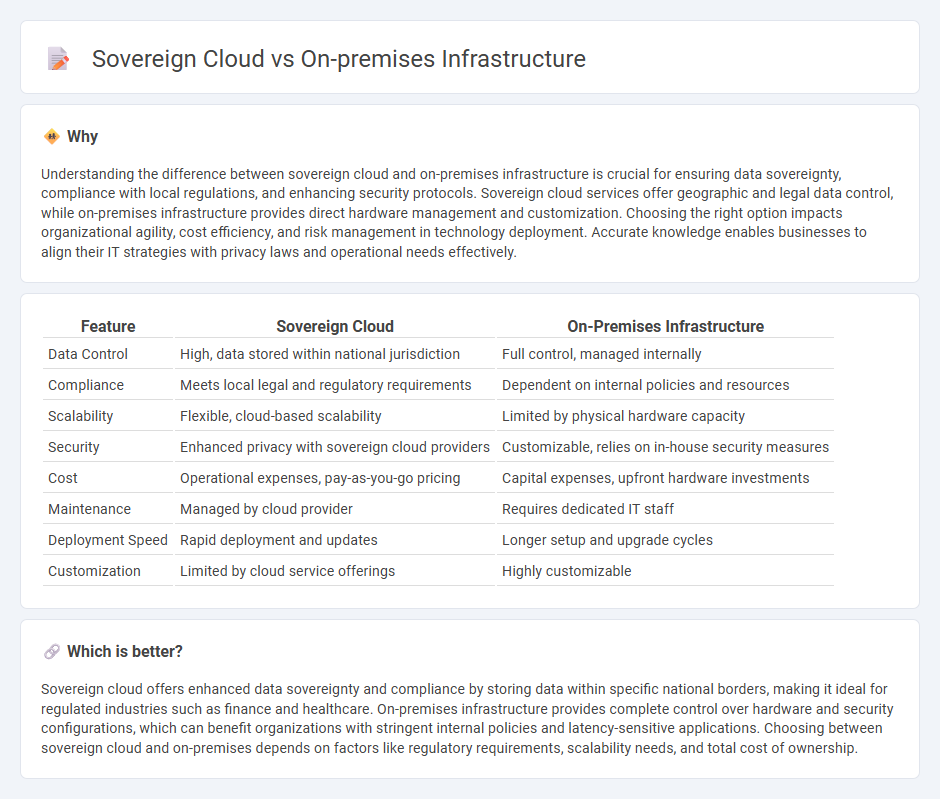
Sovereign cloud ensures data sovereignty by storing information within specific national boundaries, meeting stringent regulatory and compliance requirements. On-premises infrastructure offers full control over hardware and software environments but requires significant capital investment and maintenance resources. Explore the advantages and challenges of sovereign cloud versus on-premises infrastructure to determine the best fit for your organization's needs.
Why it is important
Understanding the difference between sovereign cloud and on-premises infrastructure is crucial for ensuring data sovereignty, compliance with local regulations, and enhancing security protocols. Sovereign cloud services offer geographic and legal data control, while on-premises infrastructure provides direct hardware management and customization. Choosing the right option impacts organizational agility, cost efficiency, and risk management in technology deployment. Accurate knowledge enables businesses to align their IT strategies with privacy laws and operational needs effectively.
Comparison Table
| Feature | Sovereign Cloud | On-Premises Infrastructure |
|---|---|---|
| Data Control | High, data stored within national jurisdiction | Full control, managed internally |
| Compliance | Meets local legal and regulatory requirements | Dependent on internal policies and resources |
| Scalability | Flexible, cloud-based scalability | Limited by physical hardware capacity |
| Security | Enhanced privacy with sovereign cloud providers | Customizable, relies on in-house security measures |
| Cost | Operational expenses, pay-as-you-go pricing | Capital expenses, upfront hardware investments |
| Maintenance | Managed by cloud provider | Requires dedicated IT staff |
| Deployment Speed | Rapid deployment and updates | Longer setup and upgrade cycles |
| Customization | Limited by cloud service offerings | Highly customizable |
Which is better?
Sovereign cloud offers enhanced data sovereignty and compliance by storing data within specific national borders, making it ideal for regulated industries such as finance and healthcare. On-premises infrastructure provides complete control over hardware and security configurations, which can benefit organizations with stringent internal policies and latency-sensitive applications. Choosing between sovereign cloud and on-premises depends on factors like regulatory requirements, scalability needs, and total cost of ownership.
Connection
Sovereign cloud and on-premises infrastructure are connected through hybrid cloud architectures that enable secure data sovereignty while maintaining local control and compliance with regulatory requirements. This integration leverages secure APIs, VPNs, and encryption protocols to ensure seamless data flow and interoperability between cloud environments and on-premises systems. Enterprises benefit from enhanced scalability, data governance, and resilience by combining sovereign cloud's strict jurisdictional safeguards with the customization and latency advantages of on-premises deployments.
Key Terms
Data Residency
On-premises infrastructure provides complete physical control over data storage, ensuring strict compliance with data residency requirements by housing sensitive information within local jurisdiction boundaries. Sovereign cloud solutions offer cloud-based services designed to meet regional data residency laws through localized data centers and governance frameworks, balancing scalability with regulatory adherence. Explore how each option aligns with your organization's data sovereignty needs to make an informed decision.
Control
On-premises infrastructure offers organizations complete control over their physical hardware, data, and security protocols, enabling tailored customization and direct management of resources. Sovereign cloud provides a cloud environment regulated by specific national laws, ensuring data sovereignty and compliance while still offering scalable cloud services. Discover how these options impact data governance and operational control to determine the best fit for your organization's needs.
Compliance
On-premises infrastructure offers direct control over data storage and security, ensuring compliance with stringent regulatory requirements such as GDPR, HIPAA, and SOX by maintaining physical ownership and localized data management. Sovereign cloud provides compliance benefits through jurisdiction-specific data residency and government-approved security protocols, enabling organizations to meet national and regional regulations while leveraging cloud scalability. Explore in-depth insights on how these solutions address evolving compliance challenges in your industry.
Source and External Links
Cloud vs. On-Premises: Exploring Key Differences - On-premises infrastructure means hosting computing resources, networking, storage, and software within a company's own physical site, offering full control but requiring ongoing management and upfront capital expenses.
On premises vs. cloud pros and cons, key differences - Advantages of on-premises include complete control over hardware and security, one-time upfront costs with potentially lower long-term expenses, better efficiency with low latency, and access that does not rely on the internet.
What is on-premises? - On-premises infrastructure provides total control and data sovereignty, suits highly regulated industries, supports legacy systems, enables high-performance computing, and serves scenarios requiring strict compliance or edge computing.
 dowidth.com
dowidth.com